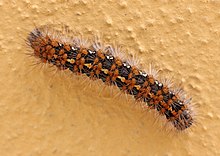Russian bear
| Russian bear | ||||||||||||
|---|---|---|---|---|---|---|---|---|---|---|---|---|

Russian bear ( Euplagia quadripunctaria ) |
||||||||||||
| Systematics | ||||||||||||
|
||||||||||||
| Scientific name | ||||||||||||
| Euplagia quadripunctaria | ||||||||||||
| ( Poda , 1761) |
The Russian bear , also called the Spanish flag , ( Euplagia quadripunctaria ) is a butterfly ( moth ) from the subfamily of the bear moth (Arctiinae). The fair bear is more closely related to him .
description
The moths reach a wingspan of 42 to 52 millimeters. They have black-blue fore wings with white or yellowish stripes. These form a distinctive "V" at the wing tips. The orange rear wings, which are conspicuous when the front wings spread (" warning look "), have three to four black-blue spots. In contrast to other bear moths , like the related beautiful bear , they have a well-trained proboscis that enables them to suck nectar from flowers, which these strikingly colored moths regularly do during the day.
The polyphagous caterpillars are about 50 millimeters long. They are black-gray and have a yellow back line. In addition, they have white spots on the sides and reddish-brown warts with short, light-colored bristles everywhere.
Occurrence
They occur in southern and central Europe , north to the Harz . You prefer semi-open terrain, such as B. Quarries , river and stream edges, dry grassland and rocky valleys and slopes. They can be found in sunny, dry as well as moist, partially shaded areas. The moths fly in one generation from July to September. They are not common, but locally numerous in some years. The moth likes to rest on light walls, but keeps its wings closed. Russian bears rarely come to light at night.
There is a large population on the Greek island of Rhodes . It is named there for the Petaloudes ( butterfly valley ), which attracts butterflies and encourages them to reproduce due to the numerous resinous oriental sweetgum trees ( Liquidambar orientalis ). The Petaloudes became famous through the Israeli satirist Ephraim Kishon , who in one of his books could not believe that such butterflies can actually be found in this valley. In Central Europe, too, hundreds of these colorful “diurnal moths” can be observed at the same time in sunny weather; especially on flowering water dost ("Kunigundenkraut") on the edge of forest paths and in front gardens on buddleia .
Food of the caterpillars
The caterpillars are polyphagous, so they eat leaves from a variety of different plants such as B .:
- Dead nettle ( Lamium spec. )
- Great nettle ( Urtica dioica )
- Little meadow button ( Sanguisorba minor )
- Adder's head ( Echium vulgare )
- Hazel ( Corylus spec. )
- Raspberry ( Rubus idaeus )
- Common blackberry (collective species) ( Rubus fruticosus agg.)
- Meadow sage ( Salvia pratensis )
- Fox's ragwort ( Senecio fuchsii )
- Forget-Me-Not ( Myosotis )
The young caterpillars mainly eat herbs ; only later do they also feed on the leaves of woody plants.
development
The females lay their eggs loosely next to each other under the leaves of the forage plants. The caterpillars hatch in September and overwinter, before pupating in a soft, white-gray web on the ground in June of the following year. The moths hatch after about a month.
literature
- Heiko Bellmann : The new Kosmos butterfly guide. Butterflies, caterpillars and forage plants. Franckh-Kosmos, Stuttgart 2003, ISBN 3-440-09330-1 .
- Heiko Bellmann: Steinbach's nature guide. Butterflies , Ulmer, Stuttgart (Hohenheim) 2010, ISBN 978-3-8001-4653-6 .
- Günter Ebert: The Butterflies of Baden-Württemberg Vol. 5, Moths III. Ulmer, Stuttgart 1997. ISBN 3-800-13481-0 .
- Manfred Koch , Wolfgang Heinicke: We identify butterflies. 3. Edition. Neumann, Radebeul 1991, ISBN 3-7402-0092-8 .
- DJ Carter, B. Hargreaves (1986): European caterpillars and butterflies and their forage plants . Paul Parey, Hamburg and Berlin.

